Refine search
No keyword found to refine search
keywords EN
Places
Names
290 documents found
| 1 | 5 |
Documents per page :
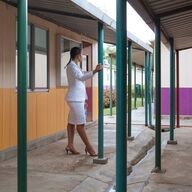
O futuro Comenca aqui
Guillaume Lassus-Dessus/Le Pictorium
LePictorium_0281942.jpg
A student gets some fresh air between classes at the "Instituto Superior de Ciências e Tecnologia de Moçambique" (Higher Institute of Science and Technology of Mozambique) in Maputo.
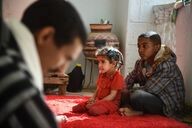
Baba El Hadj, a young schoolboy in Timbuktu, Mali.
Nicolas Réméné / Le Pictorium
LePictorium_0280387.jpg
Baba El Hadj Sidi Ahmed, 14, with his little cousin lives with his uncle Baba Moulaye Al Arby in the Djingareyber district of Timbuktu, not far from the famous mosque of the same name. Portrait of Baba El Hadj, a schoolboy in Timbuktu. Baba El Hadj Sidi Ahmed, 14, lives with his uncle Baba Moulaye Al Arby in the Djingareyber neighbourhood, not far from the famous mosque of the same name. His uncle is also the marabout of the Koranic school (Medersa) Cheick Bashir Mohamed Lemine created by his grandfather, which is adjacent to the family home and offers a traditional Muslim religious education. It is here that Baba El Hadj learns every morning to read, write and memorise the Koran in Arabic. The medersa currently accommodates about 180 young schoolchildren. At lunchtime, Baba El Hadj often eats at his uncle's house where one of his aunts, Yaya Baba, prepares Timbuktu specialities such as toukassou or widjila, before returning to the Yehia Alkaya Ibrahim secondary school. On average, Baba El Hadj spends 4 hours a day at the medersa and then 6 hours at the basic school where he studies general subjects such as French, history-geography, civic and moral education, English, mathematics and science. For the past year, two or three times a week after school, Baba El Hadj has been attending calligraphy classes with his teacher Boubacar Sadek at the Arts et Métiers workshop devoted to copyists applied to manuscripts. He would like to make a living out of it one day and copy ancient manuscripts.
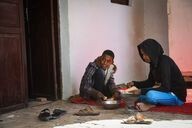
Baba El Hadj, a young schoolboy in Timbuktu, Mali.
Nicolas Réméné / Le Pictorium
LePictorium_0280388.jpg
Baba El Hadj Sidi Ahmed, 14, lives with his uncle Baba Moulaye Al Arby in the Djingareyber neighbourhood of Timbuktu, not far from the famous mosque of the same name. At lunchtime, Baba El Hadj often eats at his uncle's house where one of his aunts, Yaya Baba, prepares Timbuktu specialities such as toukassou or widjila, before returning to the Yehia Alkaya Ibrahim secondary school. Portrait of Baba El Hadj, a schoolboy in Timbuktu. Baba El Hadj Sidi Ahmed, 14, lives with his uncle Baba Moulaye Al Arby in the Djingareyber neighbourhood, not far from the famous mosque of the same name. His uncle is also the marabout of the Koranic school (Medersa) Cheick Bashir Mohamed Lemine created by his grandfather, which is adjacent to the family home and offers a traditional Muslim religious education. It is here that Baba El Hadj learns every morning to read, write and memorise the Koran in Arabic. The medersa currently accommodates about 180 young schoolchildren. At lunchtime, Baba El Hadj often eats at his uncle's house where one of his aunts, Yaya Baba, prepares Timbuktu specialities such as toukassou or widjila, before returning to the Yehia Alkaya Ibrahim secondary school. On average, Baba El Hadj spends 4 hours a day at the medersa and then 6 hours at the basic school where he studies general subjects such as French, history-geography, civic and moral education, English, mathematics and science. For the past year, two or three times a week after school, Baba El Hadj has been attending calligraphy classes with his teacher Boubacar Sadek at the Arts et Métiers workshop devoted to copyists applied to manuscripts. He would like to make a living out of it one day and copy ancient manuscripts.
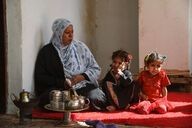
Baba El Hadj, a young schoolboy in Timbuktu, Mali.
Nicolas Réméné / Le Pictorium
LePictorium_0280389.jpg
Baba El Hadj's aunt, with her two daughters, prepares tea for the family. His brother Baba Moulaye Al Arby is the marabout of the Koranic school (Medersa) Cheick Bashir Mohamed Lemine, which was created by his grandfather, and which is adjacent to the family home. The school offers traditional Muslim religious education to around 180 young schoolchildren in the Djingareyber district of Timbuktu, not far from the famous mosque of the same name. Portrait of Baba El Hadj, a schoolboy in Timbuktu. Baba El Hadj Sidi Ahmed, 14, lives with his uncle Baba Moulaye Al Arby in the Djingareyber neighbourhood, not far from the famous mosque of the same name. His uncle is also the marabout of the Koranic school (Medersa) Cheick Bashir Mohamed Lemine created by his grandfather, which is adjacent to the family home and offers a traditional Muslim religious education. It is here that Baba El Hadj learns every morning to read, write and memorise the Koran in Arabic. The medersa currently accommodates about 180 young schoolchildren. At lunchtime, Baba El Hadj often eats at his uncle's house where one of his aunts, Yaya Baba, prepares Timbuktu specialities such as toukassou or widjila, before returning to the Yehia Alkaya Ibrahim secondary school. On average, Baba El Hadj spends 4 hours a day at the medersa and then 6 hours at the basic school where he studies general subjects such as French, history-geography, civic and moral education, English, mathematics and science. For the past year, two or three times a week after school, Baba El Hadj has been attending calligraphy classes with his teacher Boubacar Sadek at the Arts et Métiers workshop devoted to copyists applied to manuscripts. He would like to make a living out of it one day and copy ancient manuscripts.
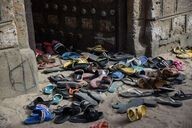
Baba El Hadj, a young schoolboy in Timbuktu, Mali.
Nicolas Réméné / Le Pictorium
LePictorium_0280390.jpg
Pairs of sandals belonging to pupils of the Koranic school (Medersa) Cheick Bashir Mohamed Lemine. The school offers traditional Muslim religious education to about 180 young schoolchildren in the Djingareyber district of Timbuktu, not far from the famous mosque of the same name. Portrait of Baba El Hadj, a schoolboy in Timbuktu. Baba El Hadj Sidi Ahmed, 14, lives with his uncle Baba Moulaye Al Arby in the Djingareyber neighbourhood, not far from the famous mosque of the same name. His uncle is also the marabout of the Koranic school (Medersa) Cheick Bashir Mohamed Lemine created by his grandfather, which is adjacent to the family home and offers a traditional Muslim religious education. It is here that Baba El Hadj learns every morning to read, write and memorise the Koran in Arabic. The medersa currently accommodates about 180 young schoolchildren. At lunchtime, Baba El Hadj often eats at his uncle's house where one of his aunts, Yaya Baba, prepares Timbuktu specialities such as toukassou or widjila, before returning to the Yehia Alkaya Ibrahim secondary school. On average, Baba El Hadj spends 4 hours a day at the medersa and then 6 hours at the basic school where he studies general subjects such as French, history-geography, civic and moral education, English, mathematics and science. For the past year, two or three times a week after school, Baba El Hadj has been attending calligraphy classes with his teacher Boubacar Sadek at the Arts et Métiers workshop devoted to copyists applied to manuscripts. He would like to make a living out of it one day and copy ancient manuscripts.
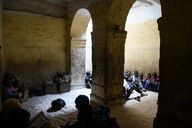
Baba El Hadj, a young schoolboy in Timbuktu, Mali.
Nicolas Réméné / Le Pictorium
LePictorium_0280391.jpg
The Koranic school (Medersa) Cheick Bashir Mohamed Lemine. The school offers traditional Muslim religious education to about 180 young schoolchildren in the Djingareyber district of Timbuktu, not far from the famous mosque of the same name. Portrait of Baba El Hadj, a schoolboy in Timbuktu. Baba El Hadj Sidi Ahmed, 14, lives with his uncle Baba Moulaye Al Arby in the Djingareyber neighbourhood, not far from the famous mosque of the same name. His uncle is also the marabout of the Koranic school (Medersa) Cheick Bashir Mohamed Lemine created by his grandfather, which is adjacent to the family home and offers a traditional Muslim religious education. It is here that Baba El Hadj learns every morning to read, write and memorise the Koran in Arabic. The medersa currently accommodates about 180 young schoolchildren. At lunchtime, Baba El Hadj often eats at his uncle's house where one of his aunts, Yaya Baba, prepares Timbuktu specialities such as toukassou or widjila, before returning to the Yehia Alkaya Ibrahim secondary school. On average, Baba El Hadj spends 4 hours a day at the medersa and then 6 hours at the basic school where he studies general subjects such as French, history-geography, civic and moral education, English, mathematics and science. For the past year, two or three times a week after school, Baba El Hadj has been attending calligraphy classes with his teacher Boubacar Sadek at the Arts et Métiers workshop devoted to copyists applied to manuscripts. He would like to make a living out of it one day and copy ancient manuscripts.
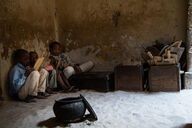
Baba El Hadj, a young schoolboy in Timbuktu, Mali.
Nicolas Réméné / Le Pictorium
LePictorium_0280392.jpg
The Koranic school (Medersa) Cheick Bashir Mohamed Lemine. The school offers traditional Muslim religious education to about 180 young schoolchildren in the Djingareyber district of Timbuktu, not far from the famous mosque of the same name. Portrait of Baba El Hadj, a schoolboy in Timbuktu. Baba El Hadj Sidi Ahmed, 14, lives with his uncle Baba Moulaye Al Arby in the Djingareyber neighbourhood, not far from the famous mosque of the same name. His uncle is also the marabout of the Koranic school (Medersa) Cheick Bashir Mohamed Lemine created by his grandfather, which is adjacent to the family home and offers a traditional Muslim religious education. It is here that Baba El Hadj learns every morning to read, write and memorise the Koran in Arabic. The medersa currently accommodates about 180 young schoolchildren. At lunchtime, Baba El Hadj often eats at his uncle's house where one of his aunts, Yaya Baba, prepares Timbuktu specialities such as toukassou or widjila, before returning to the Yehia Alkaya Ibrahim secondary school. On average, Baba El Hadj spends 4 hours a day at the medersa and then 6 hours at the basic school where he studies general subjects such as French, history-geography, civic and moral education, English, mathematics and science. For the past year, two or three times a week after school, Baba El Hadj has been attending calligraphy classes with his teacher Boubacar Sadek at the Arts et Métiers workshop devoted to copyists applied to manuscripts. He would like to make a living out of it one day and copy ancient manuscripts.

Baba El Hadj, a young schoolboy in Timbuktu, Mali.
Nicolas Réméné / Le Pictorium
LePictorium_0280393.jpg
The Koranic school (Medersa) Cheick Bashir Mohamed Lemine. The school offers traditional Muslim religious education to about 180 young schoolchildren in the Djingareyber district of Timbuktu, not far from the famous mosque of the same name. Portrait of Baba El Hadj, a schoolboy in Timbuktu. Baba El Hadj Sidi Ahmed, 14, lives with his uncle Baba Moulaye Al Arby in the Djingareyber neighbourhood, not far from the famous mosque of the same name. His uncle is also the marabout of the Koranic school (Medersa) Cheick Bashir Mohamed Lemine created by his grandfather, which is adjacent to the family home and offers a traditional Muslim religious education. It is here that Baba El Hadj learns every morning to read, write and memorise the Koran in Arabic. The medersa currently accommodates about 180 young schoolchildren. At lunchtime, Baba El Hadj often eats at his uncle's house where one of his aunts, Yaya Baba, prepares Timbuktu specialities such as toukassou or widjila, before returning to the Yehia Alkaya Ibrahim secondary school. On average, Baba El Hadj spends 4 hours a day at the medersa and then 6 hours at the basic school where he studies general subjects such as French, history-geography, civic and moral education, English, mathematics and science. For the past year, two or three times a week after school, Baba El Hadj has been attending calligraphy classes with his teacher Boubacar Sadek at the Arts et Métiers workshop devoted to copyists applied to manuscripts. He would like to make a living out of it one day and copy ancient manuscripts.
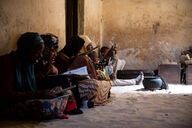
Baba El Hadj, a young schoolboy in Timbuktu, Mali.
Nicolas Réméné / Le Pictorium
LePictorium_0280394.jpg
The Koranic school (Medersa) Cheick Bashir Mohamed Lemine. The school offers traditional Muslim religious education to about 180 young schoolchildren in the Djingareyber district of Timbuktu, not far from the famous mosque of the same name. Portrait of Baba El Hadj, a schoolboy in Timbuktu. Baba El Hadj Sidi Ahmed, 14, lives with his uncle Baba Moulaye Al Arby in the Djingareyber neighbourhood, not far from the famous mosque of the same name. His uncle is also the marabout of the Koranic school (Medersa) Cheick Bashir Mohamed Lemine created by his grandfather, which is adjacent to the family home and offers a traditional Muslim religious education. It is here that Baba El Hadj learns every morning to read, write and memorise the Koran in Arabic. The medersa currently accommodates about 180 young schoolchildren. At lunchtime, Baba El Hadj often eats at his uncle's house where one of his aunts, Yaya Baba, prepares Timbuktu specialities such as toukassou or widjila, before returning to the Yehia Alkaya Ibrahim secondary school. On average, Baba El Hadj spends 4 hours a day at the medersa and then 6 hours at the basic school where he studies general subjects such as French, history-geography, civic and moral education, English, mathematics and science. For the past year, two or three times a week after school, Baba El Hadj has been attending calligraphy classes with his teacher Boubacar Sadek at the Arts et Métiers workshop devoted to copyists applied to manuscripts. He would like to make a living out of it one day and copy ancient manuscripts.
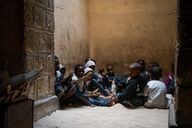
Baba El Hadj, a young schoolboy in Timbuktu, Mali.
Nicolas Réméné / Le Pictorium
LePictorium_0280395.jpg
The Koranic school (Medersa) Cheick Bashir Mohamed Lemine. The school offers traditional Muslim religious education to about 180 young schoolchildren in the Djingareyber district of Timbuktu, not far from the famous mosque of the same name. Portrait of Baba El Hadj, a schoolboy in Timbuktu. Baba El Hadj Sidi Ahmed, 14, lives with his uncle Baba Moulaye Al Arby in the Djingareyber neighbourhood, not far from the famous mosque of the same name. His uncle is also the marabout of the Koranic school (Medersa) Cheick Bashir Mohamed Lemine created by his grandfather, which is adjacent to the family home and offers a traditional Muslim religious education. It is here that Baba El Hadj learns every morning to read, write and memorise the Koran in Arabic. The medersa currently accommodates about 180 young schoolchildren. At lunchtime, Baba El Hadj often eats at his uncle's house where one of his aunts, Yaya Baba, prepares Timbuktu specialities such as toukassou or widjila, before returning to the Yehia Alkaya Ibrahim secondary school. On average, Baba El Hadj spends 4 hours a day at the medersa and then 6 hours at the basic school where he studies general subjects such as French, history-geography, civic and moral education, English, mathematics and science. For the past year, two or three times a week after school, Baba El Hadj has been attending calligraphy classes with his teacher Boubacar Sadek at the Arts et Métiers workshop devoted to copyists applied to manuscripts. He would like to make a living out of it one day and copy ancient manuscripts.
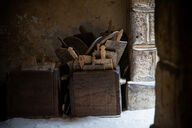
Baba El Hadj, a young schoolboy in Timbuktu, Mali.
Nicolas Réméné / Le Pictorium
LePictorium_0280396.jpg
Koranic tablets used to write down verses from the Koran but also religious texts of different natures. The Koranic school (Medersa) Cheick Bashir Mohamed Lemine. The school offers traditional Muslim religious education to about 180 young schoolchildren in the Djingareyber district of Timbuktu, not far from the famous mosque of the same name. Portrait of Baba El Hadj, a schoolboy in Timbuktu. Baba El Hadj Sidi Ahmed, 14, lives with his uncle Baba Moulaye Al Arby in the Djingareyber neighbourhood, not far from the famous mosque of the same name. His uncle is also the marabout of the Koranic school (Medersa) Cheick Bashir Mohamed Lemine created by his grandfather, which is adjacent to the family home and offers a traditional Muslim religious education. It is here that Baba El Hadj learns every morning to read, write and memorise the Koran in Arabic. The medersa currently accommodates about 180 young schoolchildren. At lunchtime, Baba El Hadj often eats at his uncle's house where one of his aunts, Yaya Baba, prepares Timbuktu specialities such as toukassou or widjila, before returning to the Yehia Alkaya Ibrahim secondary school. On average, Baba El Hadj spends 4 hours a day at the medersa and then 6 hours at the basic school where he studies general subjects such as French, history-geography, civic and moral education, English, mathematics and science. For the past year, two or three times a week after school, Baba El Hadj has been attending calligraphy classes with his teacher Boubacar Sadek at the Arts et Métiers workshop devoted to copyists applied to manuscripts. He would like to make a living out of it one day and copy ancient manuscripts.
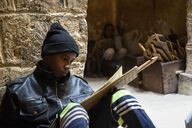
Baba El Hadj, a young schoolboy in Timbuktu, Mali.
Nicolas Réméné / Le Pictorium
LePictorium_0280397.jpg
The Koranic school (Medersa) Cheick Bashir Mohamed Lemine. The school offers traditional Muslim religious education to about 180 young schoolchildren in the Djingareyber district of Timbuktu, not far from the famous mosque of the same name. Portrait of Baba El Hadj, a schoolboy in Timbuktu. Baba El Hadj Sidi Ahmed, 14, lives with his uncle Baba Moulaye Al Arby in the Djingareyber neighbourhood, not far from the famous mosque of the same name. His uncle is also the marabout of the Koranic school (Medersa) Cheick Bashir Mohamed Lemine created by his grandfather, which is adjacent to the family home and offers a traditional Muslim religious education. It is here that Baba El Hadj learns every morning to read, write and memorise the Koran in Arabic. The medersa currently accommodates about 180 young schoolchildren. At lunchtime, Baba El Hadj often eats at his uncle's house where one of his aunts, Yaya Baba, prepares Timbuktu specialities such as toukassou or widjila, before returning to the Yehia Alkaya Ibrahim secondary school. On average, Baba El Hadj spends 4 hours a day at the medersa and then 6 hours at the basic school where he studies general subjects such as French, history-geography, civic and moral education, English, mathematics and science. For the past year, two or three times a week after school, Baba El Hadj has been attending calligraphy classes with his teacher Boubacar Sadek at the Arts et Métiers workshop devoted to copyists applied to manuscripts. He would like to make a living out of it one day and copy ancient manuscripts.
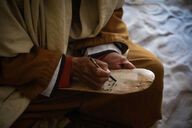
Baba El Hadj, a young schoolboy in Timbuktu, Mali.
Nicolas Réméné / Le Pictorium
LePictorium_0280398.jpg
The Koranic school (Medersa) Cheick Bashir Mohamed Lemine. The school offers traditional Muslim religious education to about 180 young schoolchildren in the Djingareyber district of Timbuktu, not far from the famous mosque of the same name. Portrait of Baba El Hadj, a schoolboy in Timbuktu. Baba El Hadj Sidi Ahmed, 14, lives with his uncle Baba Moulaye Al Arby in the Djingareyber neighbourhood, not far from the famous mosque of the same name. His uncle is also the marabout of the Koranic school (Medersa) Cheick Bashir Mohamed Lemine created by his grandfather, which is adjacent to the family home and offers a traditional Muslim religious education. It is here that Baba El Hadj learns every morning to read, write and memorise the Koran in Arabic. The medersa currently accommodates about 180 young schoolchildren. At lunchtime, Baba El Hadj often eats at his uncle's house where one of his aunts, Yaya Baba, prepares Timbuktu specialities such as toukassou or widjila, before returning to the Yehia Alkaya Ibrahim secondary school. On average, Baba El Hadj spends 4 hours a day at the medersa and then 6 hours at the basic school where he studies general subjects such as French, history-geography, civic and moral education, English, mathematics and science. For the past year, two or three times a week after school, Baba El Hadj has been attending calligraphy classes with his teacher Boubacar Sadek at the Arts et Métiers workshop devoted to copyists applied to manuscripts. He would like to make a living out of it one day and copy ancient manuscripts.

Baba El Hadj, a young schoolboy in Timbuktu, Mali.
Nicolas Réméné / Le Pictorium
LePictorium_0280399.jpg
The Koranic school (Medersa) Cheick Bashir Mohamed Lemine. The school offers traditional Muslim religious education to about 180 young schoolchildren in the Djingareyber district of Timbuktu, not far from the famous mosque of the same name. Portrait of Baba El Hadj, a schoolboy in Timbuktu. Baba El Hadj Sidi Ahmed, 14, lives with his uncle Baba Moulaye Al Arby in the Djingareyber neighbourhood, not far from the famous mosque of the same name. His uncle is also the marabout of the Koranic school (Medersa) Cheick Bashir Mohamed Lemine created by his grandfather, which is adjacent to the family home and offers a traditional Muslim religious education. It is here that Baba El Hadj learns every morning to read, write and memorise the Koran in Arabic. The medersa currently accommodates about 180 young schoolchildren. At lunchtime, Baba El Hadj often eats at his uncle's house where one of his aunts, Yaya Baba, prepares Timbuktu specialities such as toukassou or widjila, before returning to the Yehia Alkaya Ibrahim secondary school. On average, Baba El Hadj spends 4 hours a day at the medersa and then 6 hours at the basic school where he studies general subjects such as French, history-geography, civic and moral education, English, mathematics and science. For the past year, two or three times a week after school, Baba El Hadj has been attending calligraphy classes with his teacher Boubacar Sadek at the Arts et Métiers workshop devoted to copyists applied to manuscripts. He would like to make a living out of it one day and copy ancient manuscripts.
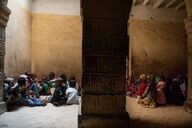
Baba El Hadj, a young schoolboy in Timbuktu, Mali.
Nicolas Réméné / Le Pictorium
LePictorium_0280400.jpg
The Koranic school (Medersa) Cheick Bashir Mohamed Lemine. The school offers traditional Muslim religious education to about 180 young schoolchildren in the Djingareyber district of Timbuktu, not far from the famous mosque of the same name. Portrait of Baba El Hadj, a schoolboy in Timbuktu. Baba El Hadj Sidi Ahmed, 14, lives with his uncle Baba Moulaye Al Arby in the Djingareyber neighbourhood, not far from the famous mosque of the same name. His uncle is also the marabout of the Koranic school (Medersa) Cheick Bashir Mohamed Lemine created by his grandfather, which is adjacent to the family home and offers a traditional Muslim religious education. It is here that Baba El Hadj learns every morning to read, write and memorise the Koran in Arabic. The medersa currently accommodates about 180 young schoolchildren. At lunchtime, Baba El Hadj often eats at his uncle's house where one of his aunts, Yaya Baba, prepares Timbuktu specialities such as toukassou or widjila, before returning to the Yehia Alkaya Ibrahim secondary school. On average, Baba El Hadj spends 4 hours a day at the medersa and then 6 hours at the basic school where he studies general subjects such as French, history-geography, civic and moral education, English, mathematics and science. For the past year, two or three times a week after school, Baba El Hadj has been attending calligraphy classes with his teacher Boubacar Sadek at the Arts et Métiers workshop devoted to copyists applied to manuscripts. He would like to make a living out of it one day and copy ancient manuscripts.
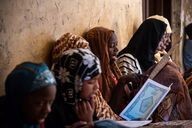
Baba El Hadj, a young schoolboy in Timbuktu, Mali.
Nicolas Réméné / Le Pictorium
LePictorium_0280401.jpg
The Koranic school (Medersa) Cheick Bashir Mohamed Lemine. The school offers traditional Muslim religious education to about 180 young schoolchildren in the Djingareyber district of Timbuktu, not far from the famous mosque of the same name. Portrait of Baba El Hadj, a schoolboy in Timbuktu. Baba El Hadj Sidi Ahmed, 14, lives with his uncle Baba Moulaye Al Arby in the Djingareyber neighbourhood, not far from the famous mosque of the same name. His uncle is also the marabout of the Koranic school (Medersa) Cheick Bashir Mohamed Lemine created by his grandfather, which is adjacent to the family home and offers a traditional Muslim religious education. It is here that Baba El Hadj learns every morning to read, write and memorise the Koran in Arabic. The medersa currently accommodates about 180 young schoolchildren. At lunchtime, Baba El Hadj often eats at his uncle's house where one of his aunts, Yaya Baba, prepares Timbuktu specialities such as toukassou or widjila, before returning to the Yehia Alkaya Ibrahim secondary school. On average, Baba El Hadj spends 4 hours a day at the medersa and then 6 hours at the basic school where he studies general subjects such as French, history-geography, civic and moral education, English, mathematics and science. For the past year, two or three times a week after school, Baba El Hadj has been attending calligraphy classes with his teacher Boubacar Sadek at the Arts et Métiers workshop devoted to copyists applied to manuscripts. He would like to make a living out of it one day and copy ancient manuscripts.
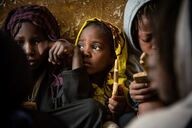
Baba El Hadj, a young schoolboy in Timbuktu, Mali.
Nicolas Réméné / Le Pictorium
LePictorium_0280402.jpg
The Koranic school (Medersa) Cheick Bashir Mohamed Lemine. The school offers traditional Muslim religious education to about 180 young schoolchildren in the Djingareyber district of Timbuktu, not far from the famous mosque of the same name. Portrait of Baba El Hadj, a schoolboy in Timbuktu. Baba El Hadj Sidi Ahmed, 14, lives with his uncle Baba Moulaye Al Arby in the Djingareyber neighbourhood, not far from the famous mosque of the same name. His uncle is also the marabout of the Koranic school (Medersa) Cheick Bashir Mohamed Lemine created by his grandfather, which is adjacent to the family home and offers a traditional Muslim religious education. It is here that Baba El Hadj learns every morning to read, write and memorise the Koran in Arabic. The medersa currently accommodates about 180 young schoolchildren. At lunchtime, Baba El Hadj often eats at his uncle's house where one of his aunts, Yaya Baba, prepares Timbuktu specialities such as toukassou or widjila, before returning to the Yehia Alkaya Ibrahim secondary school. On average, Baba El Hadj spends 4 hours a day at the medersa and then 6 hours at the basic school where he studies general subjects such as French, history-geography, civic and moral education, English, mathematics and science. For the past year, two or three times a week after school, Baba El Hadj has been attending calligraphy classes with his teacher Boubacar Sadek at the Arts et Métiers workshop devoted to copyists applied to manuscripts. He would like to make a living out of it one day and copy ancient manuscripts.
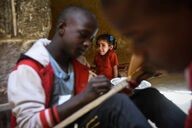
Baba El Hadj, a young schoolboy in Timbuktu, Mali.
Nicolas Réméné / Le Pictorium
LePictorium_0280403.jpg
The Koranic school (Medersa) Cheick Bashir Mohamed Lemine. The school offers traditional Muslim religious education to about 180 young schoolchildren in the Djingareyber district of Timbuktu, not far from the famous mosque of the same name. Portrait of Baba El Hadj, a schoolboy in Timbuktu. Baba El Hadj Sidi Ahmed, 14, lives with his uncle Baba Moulaye Al Arby in the Djingareyber neighbourhood, not far from the famous mosque of the same name. His uncle is also the marabout of the Koranic school (Medersa) Cheick Bashir Mohamed Lemine created by his grandfather, which is adjacent to the family home and offers a traditional Muslim religious education. It is here that Baba El Hadj learns every morning to read, write and memorise the Koran in Arabic. The medersa currently accommodates about 180 young schoolchildren. At lunchtime, Baba El Hadj often eats at his uncle's house where one of his aunts, Yaya Baba, prepares Timbuktu specialities such as toukassou or widjila, before returning to the Yehia Alkaya Ibrahim secondary school. On average, Baba El Hadj spends 4 hours a day at the medersa and then 6 hours at the basic school where he studies general subjects such as French, history-geography, civic and moral education, English, mathematics and science. For the past year, two or three times a week after school, Baba El Hadj has been attending calligraphy classes with his teacher Boubacar Sadek at the Arts et Métiers workshop devoted to copyists applied to manuscripts. He would like to make a living out of it one day and copy ancient manuscripts.

Baba El Hadj, a young schoolboy in Timbuktu, Mali.
Nicolas Réméné / Le Pictorium
LePictorium_0280404.jpg
The Koranic school (Medersa) Cheick Bashir Mohamed Lemine. The school offers traditional Muslim religious education to about 180 young schoolchildren in the Djingareyber district of Timbuktu, not far from the famous mosque of the same name. Portrait of Baba El Hadj, a schoolboy in Timbuktu. Baba El Hadj Sidi Ahmed, 14, lives with his uncle Baba Moulaye Al Arby in the Djingareyber neighbourhood, not far from the famous mosque of the same name. His uncle is also the marabout of the Koranic school (Medersa) Cheick Bashir Mohamed Lemine created by his grandfather, which is adjacent to the family home and offers a traditional Muslim religious education. It is here that Baba El Hadj learns every morning to read, write and memorise the Koran in Arabic. The medersa currently accommodates about 180 young schoolchildren. At lunchtime, Baba El Hadj often eats at his uncle's house where one of his aunts, Yaya Baba, prepares Timbuktu specialities such as toukassou or widjila, before returning to the Yehia Alkaya Ibrahim secondary school. On average, Baba El Hadj spends 4 hours a day at the medersa and then 6 hours at the basic school where he studies general subjects such as French, history-geography, civic and moral education, English, mathematics and science. For the past year, two or three times a week after school, Baba El Hadj has been attending calligraphy classes with his teacher Boubacar Sadek at the Arts et Métiers workshop devoted to copyists applied to manuscripts. He would like to make a living out of it one day and copy ancient manuscripts.

Baba El Hadj, a young schoolboy in Timbuktu, Mali.
Nicolas Réméné / Le Pictorium
LePictorium_0280405.jpg
For the past year, two or three times a week after school, Baba El Hadj has been attending calligraphy classes with his teacher Boubacar Sadek at the Arts et Métiers workshop for manuscript copyists. The workshop is also located in the Djingareyber district, not far from the famous mosque of the same name in Timbuktu. He would like to make a living out of it one day and copy ancient manuscripts. Portrait of Baba El Hadj, a schoolboy in Timbuktu. Baba El Hadj Sidi Ahmed, 14, lives with his uncle Baba Moulaye Al Arby in the Djingareyber neighbourhood, not far from the famous mosque of the same name. His uncle is also the marabout of the Koranic school (Medersa) Cheick Bashir Mohamed Lemine created by his grandfather, which is adjacent to the family home and offers a traditional Muslim religious education. It is here that Baba El Hadj learns every morning to read, write and memorise the Koran in Arabic. The medersa currently accommodates about 180 young schoolchildren. At lunchtime, Baba El Hadj often eats at his uncle's house where one of his aunts, Yaya Baba, prepares Timbuktu specialities such as toukassou or widjila, before returning to the Yehia Alkaya Ibrahim secondary school. On average, Baba El Hadj spends 4 hours a day at the medersa and then 6 hours at the basic school where he studies general subjects such as French, history-geography, civic and moral education, English, mathematics and science. For the past year, two or three times a week after school, Baba El Hadj has been attending calligraphy classes with his teacher Boubacar Sadek at the Arts et Métiers workshop devoted to copyists applied to manuscripts. He would like to make a living out of it one day and copy ancient manuscripts.

Baba El Hadj, a young schoolboy in Timbuktu, Mali.
Nicolas Réméné / Le Pictorium
LePictorium_0280406.jpg
For the past year, two or three times a week after school, Baba El Hadj has been attending calligraphy classes with his teacher Boubacar Sadek at the Arts et Métiers workshop for manuscript copyists. The workshop is also located in the Djingareyber district, not far from the famous mosque of the same name in Timbuktu. He would like to make a living out of it one day and copy ancient manuscripts. Portrait of Baba El Hadj, a schoolboy in Timbuktu. Baba El Hadj Sidi Ahmed, 14, lives with his uncle Baba Moulaye Al Arby in the Djingareyber neighbourhood, not far from the famous mosque of the same name. His uncle is also the marabout of the Koranic school (Medersa) Cheick Bashir Mohamed Lemine created by his grandfather, which is adjacent to the family home and offers a traditional Muslim religious education. It is here that Baba El Hadj learns every morning to read, write and memorise the Koran in Arabic. The medersa currently accommodates about 180 young schoolchildren. At lunchtime, Baba El Hadj often eats at his uncle's house where one of his aunts, Yaya Baba, prepares Timbuktu specialities such as toukassou or widjila, before returning to the Yehia Alkaya Ibrahim secondary school. On average, Baba El Hadj spends 4 hours a day at the medersa and then 6 hours at the basic school where he studies general subjects such as French, history-geography, civic and moral education, English, mathematics and science. For the past year, two or three times a week after school, Baba El Hadj has been attending calligraphy classes with his teacher Boubacar Sadek at the Arts et Métiers workshop devoted to copyists applied to manuscripts. He would like to make a living out of it one day and copy ancient manuscripts.
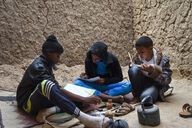
Baba El Hadj, a young schoolboy in Timbuktu, Mali.
Nicolas Réméné / Le Pictorium
LePictorium_0280407.jpg
For the past year, two or three times a week after school, Baba El Hadj has been attending calligraphy classes with his teacher Boubacar Sadek at the Arts et Métiers workshop for manuscript copyists. The workshop is also located in the Djingareyber district, not far from the famous mosque of the same name in Timbuktu. He would like to make a living out of it one day and copy ancient manuscripts. Portrait of Baba El Hadj, a schoolboy in Timbuktu. Baba El Hadj Sidi Ahmed, 14, lives with his uncle Baba Moulaye Al Arby in the Djingareyber neighbourhood, not far from the famous mosque of the same name. His uncle is also the marabout of the Koranic school (Medersa) Cheick Bashir Mohamed Lemine created by his grandfather, which is adjacent to the family home and offers a traditional Muslim religious education. It is here that Baba El Hadj learns every morning to read, write and memorise the Koran in Arabic. The medersa currently accommodates about 180 young schoolchildren. At lunchtime, Baba El Hadj often eats at his uncle's house where one of his aunts, Yaya Baba, prepares Timbuktu specialities such as toukassou or widjila, before returning to the Yehia Alkaya Ibrahim secondary school. On average, Baba El Hadj spends 4 hours a day at the medersa and then 6 hours at the basic school where he studies general subjects such as French, history-geography, civic and moral education, English, mathematics and science. For the past year, two or three times a week after school, Baba El Hadj has been attending calligraphy classes with his teacher Boubacar Sadek at the Arts et Métiers workshop devoted to copyists applied to manuscripts. He would like to make a living out of it one day and copy ancient manuscripts.
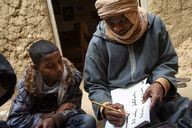
Baba El Hadj, a young schoolboy in Timbuktu, Mali.
Nicolas Réméné / Le Pictorium
LePictorium_0280408.jpg
For the past year, two or three times a week after school, Baba El Hadj has been attending calligraphy classes with his teacher Boubacar Sadek at the Arts et Métiers workshop for manuscript copyists. The workshop is also located in the Djingareyber district, not far from the famous mosque of the same name in Timbuktu. He would like to make a living out of it one day and copy ancient manuscripts. Portrait of Baba El Hadj, a schoolboy in Timbuktu. Baba El Hadj Sidi Ahmed, 14, lives with his uncle Baba Moulaye Al Arby in the Djingareyber neighbourhood, not far from the famous mosque of the same name. His uncle is also the marabout of the Koranic school (Medersa) Cheick Bashir Mohamed Lemine created by his grandfather, which is adjacent to the family home and offers a traditional Muslim religious education. It is here that Baba El Hadj learns every morning to read, write and memorise the Koran in Arabic. The medersa currently accommodates about 180 young schoolchildren. At lunchtime, Baba El Hadj often eats at his uncle's house where one of his aunts, Yaya Baba, prepares Timbuktu specialities such as toukassou or widjila, before returning to the Yehia Alkaya Ibrahim secondary school. On average, Baba El Hadj spends 4 hours a day at the medersa and then 6 hours at the basic school where he studies general subjects such as French, history-geography, civic and moral education, English, mathematics and science. For the past year, two or three times a week after school, Baba El Hadj has been attending calligraphy classes with his teacher Boubacar Sadek at the Arts et Métiers workshop devoted to copyists applied to manuscripts. He would like to make a living out of it one day and copy ancient manuscripts.
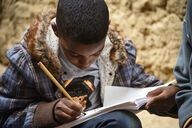
Baba El Hadj, a young schoolboy in Timbuktu, Mali.
Nicolas Réméné / Le Pictorium
LePictorium_0280409.jpg
For the past year, two or three times a week after school, Baba El Hadj has been attending calligraphy classes with his teacher Boubacar Sadek at the Arts et Métiers workshop for manuscript copyists. The workshop is also located in the Djingareyber district, not far from the famous mosque of the same name in Timbuktu. He would like to make a living out of it one day and copy ancient manuscripts. Portrait of Baba El Hadj, a schoolboy in Timbuktu. Baba El Hadj Sidi Ahmed, 14, lives with his uncle Baba Moulaye Al Arby in the Djingareyber neighbourhood, not far from the famous mosque of the same name. His uncle is also the marabout of the Koranic school (Medersa) Cheick Bashir Mohamed Lemine created by his grandfather, which is adjacent to the family home and offers a traditional Muslim religious education. It is here that Baba El Hadj learns every morning to read, write and memorise the Koran in Arabic. The medersa currently accommodates about 180 young schoolchildren. At lunchtime, Baba El Hadj often eats at his uncle's house where one of his aunts, Yaya Baba, prepares Timbuktu specialities such as toukassou or widjila, before returning to the Yehia Alkaya Ibrahim secondary school. On average, Baba El Hadj spends 4 hours a day at the medersa and then 6 hours at the basic school where he studies general subjects such as French, history-geography, civic and moral education, English, mathematics and science. For the past year, two or three times a week after school, Baba El Hadj has been attending calligraphy classes with his teacher Boubacar Sadek at the Arts et Métiers workshop devoted to copyists applied to manuscripts. He would like to make a living out of it one day and copy ancient manuscripts.
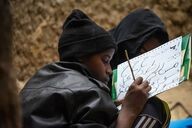
Baba El Hadj, a young schoolboy in Timbuktu, Mali.
Nicolas Réméné / Le Pictorium
LePictorium_0280410.jpg
For the past year, two or three times a week after school, Baba El Hadj has been attending calligraphy classes with his teacher Boubacar Sadek at the Arts et Métiers workshop for manuscript copyists. The workshop is also located in the Djingareyber district, not far from the famous mosque of the same name in Timbuktu. He would like to make a living out of it one day and copy ancient manuscripts. Portrait of Baba El Hadj, a schoolboy in Timbuktu. Baba El Hadj Sidi Ahmed, 14, lives with his uncle Baba Moulaye Al Arby in the Djingareyber neighbourhood, not far from the famous mosque of the same name. His uncle is also the marabout of the Koranic school (Medersa) Cheick Bashir Mohamed Lemine created by his grandfather, which is adjacent to the family home and offers a traditional Muslim religious education. It is here that Baba El Hadj learns every morning to read, write and memorise the Koran in Arabic. The medersa currently accommodates about 180 young schoolchildren. At lunchtime, Baba El Hadj often eats at his uncle's house where one of his aunts, Yaya Baba, prepares Timbuktu specialities such as toukassou or widjila, before returning to the Yehia Alkaya Ibrahim secondary school. On average, Baba El Hadj spends 4 hours a day at the medersa and then 6 hours at the basic school where he studies general subjects such as French, history-geography, civic and moral education, English, mathematics and science. For the past year, two or three times a week after school, Baba El Hadj has been attending calligraphy classes with his teacher Boubacar Sadek at the Arts et Métiers workshop devoted to copyists applied to manuscripts. He would like to make a living out of it one day and copy ancient manuscripts.
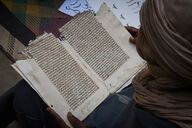
Baba El Hadj, a young schoolboy in Timbuktu, Mali.
Nicolas Réméné / Le Pictorium
LePictorium_0280411.jpg
For the past year, two or three times a week after school, Baba El Hadj has been attending calligraphy classes with his teacher Boubacar Sadek at the Arts et Métiers workshop for manuscript copyists. The workshop is also located in the Djingareyber district, not far from the famous mosque of the same name in Timbuktu. He would like to make a living out of it one day and copy ancient manuscripts. Portrait of Baba El Hadj, a schoolboy in Timbuktu. Baba El Hadj Sidi Ahmed, 14, lives with his uncle Baba Moulaye Al Arby in the Djingareyber neighbourhood, not far from the famous mosque of the same name. His uncle is also the marabout of the Koranic school (Medersa) Cheick Bashir Mohamed Lemine created by his grandfather, which is adjacent to the family home and offers a traditional Muslim religious education. It is here that Baba El Hadj learns every morning to read, write and memorise the Koran in Arabic. The medersa currently accommodates about 180 young schoolchildren. At lunchtime, Baba El Hadj often eats at his uncle's house where one of his aunts, Yaya Baba, prepares Timbuktu specialities such as toukassou or widjila, before returning to the Yehia Alkaya Ibrahim secondary school. On average, Baba El Hadj spends 4 hours a day at the medersa and then 6 hours at the basic school where he studies general subjects such as French, history-geography, civic and moral education, English, mathematics and science. For the past year, two or three times a week after school, Baba El Hadj has been attending calligraphy classes with his teacher Boubacar Sadek at the Arts et Métiers workshop devoted to copyists applied to manuscripts. He would like to make a living out of it one day and copy ancient manuscripts.
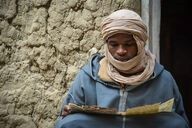
Baba El Hadj, a young schoolboy in Timbuktu, Mali.
Nicolas Réméné / Le Pictorium
LePictorium_0280412.jpg
For the past year, two or three times a week after school, Baba El Hadj has been attending calligraphy classes with his teacher Boubacar Sadek at the Arts et Métiers workshop for manuscript copyists. The workshop is also located in the Djingareyber district, not far from the famous mosque of the same name in Timbuktu. He would like to make a living out of it one day and copy ancient manuscripts. Portrait of Baba El Hadj, a schoolboy in Timbuktu. Baba El Hadj Sidi Ahmed, 14, lives with his uncle Baba Moulaye Al Arby in the Djingareyber neighbourhood, not far from the famous mosque of the same name. His uncle is also the marabout of the Koranic school (Medersa) Cheick Bashir Mohamed Lemine created by his grandfather, which is adjacent to the family home and offers a traditional Muslim religious education. It is here that Baba El Hadj learns every morning to read, write and memorise the Koran in Arabic. The medersa currently accommodates about 180 young schoolchildren. At lunchtime, Baba El Hadj often eats at his uncle's house where one of his aunts, Yaya Baba, prepares Timbuktu specialities such as toukassou or widjila, before returning to the Yehia Alkaya Ibrahim secondary school. On average, Baba El Hadj spends 4 hours a day at the medersa and then 6 hours at the basic school where he studies general subjects such as French, history-geography, civic and moral education, English, mathematics and science. For the past year, two or three times a week after school, Baba El Hadj has been attending calligraphy classes with his teacher Boubacar Sadek at the Arts et Métiers workshop devoted to copyists applied to manuscripts. He would like to make a living out of it one day and copy ancient manuscripts.
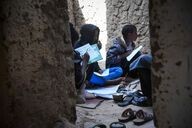
Baba El Hadj, a young schoolboy in Timbuktu, Mali.
Nicolas Réméné / Le Pictorium
LePictorium_0280413.jpg
For the past year, two or three times a week after school, Baba El Hadj has been attending calligraphy classes with his teacher Boubacar Sadek at the Arts et Métiers workshop for manuscript copyists. The workshop is also located in the Djingareyber district, not far from the famous mosque of the same name in Timbuktu. He would like to make a living out of it one day and copy ancient manuscripts. Portrait of Baba El Hadj, a schoolboy in Timbuktu. Baba El Hadj Sidi Ahmed, 14, lives with his uncle Baba Moulaye Al Arby in the Djingareyber neighbourhood, not far from the famous mosque of the same name. His uncle is also the marabout of the Koranic school (Medersa) Cheick Bashir Mohamed Lemine created by his grandfather, which is adjacent to the family home and offers a traditional Muslim religious education. It is here that Baba El Hadj learns every morning to read, write and memorise the Koran in Arabic. The medersa currently accommodates about 180 young schoolchildren. At lunchtime, Baba El Hadj often eats at his uncle's house where one of his aunts, Yaya Baba, prepares Timbuktu specialities such as toukassou or widjila, before returning to the Yehia Alkaya Ibrahim secondary school. On average, Baba El Hadj spends 4 hours a day at the medersa and then 6 hours at the basic school where he studies general subjects such as French, history-geography, civic and moral education, English, mathematics and science. For the past year, two or three times a week after school, Baba El Hadj has been attending calligraphy classes with his teacher Boubacar Sadek at the Arts et Métiers workshop devoted to copyists applied to manuscripts. He would like to make a living out of it one day and copy ancient manuscripts.
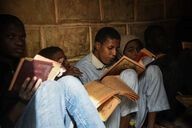
Baba El Hadj, a young schoolboy in Timbuktu, Mali.
Nicolas Réméné / Le Pictorium
LePictorium_0280414.jpg
The Koranic school (Medersa) Cheick Bashir Mohamed Lemine. The school offers traditional Muslim religious education to about 180 young schoolchildren in the Djingareyber district of Timbuktu, not far from the famous mosque of the same name. Portrait of Baba El Hadj, a schoolboy in Timbuktu. Baba El Hadj Sidi Ahmed, 14, lives with his uncle Baba Moulaye Al Arby in the Djingareyber neighbourhood, not far from the famous mosque of the same name. His uncle is also the marabout of the Koranic school (Medersa) Cheick Bashir Mohamed Lemine created by his grandfather, which is adjacent to the family home and offers a traditional Muslim religious education. It is here that Baba El Hadj learns every morning to read, write and memorise the Koran in Arabic. The medersa currently accommodates about 180 young schoolchildren. At lunchtime, Baba El Hadj often eats at his uncle's house where one of his aunts, Yaya Baba, prepares Timbuktu specialities such as toukassou or widjila, before returning to the Yehia Alkaya Ibrahim secondary school. On average, Baba El Hadj spends 4 hours a day at the medersa and then 6 hours at the basic school where he studies general subjects such as French, history-geography, civic and moral education, English, mathematics and science. For the past year, two or three times a week after school, Baba El Hadj has been attending calligraphy classes with his teacher Boubacar Sadek at the Arts et Métiers workshop devoted to copyists applied to manuscripts. He would like to make a living out of it one day and copy ancient manuscripts.

Baba El Hadj, a young schoolboy in Timbuktu, Mali.
Nicolas Réméné / Le Pictorium
LePictorium_0280415.jpg
The Koranic school (Medersa) Cheick Bashir Mohamed Lemine. The school offers traditional Muslim religious education to about 180 young schoolchildren in the Djingareyber district of Timbuktu, not far from the famous mosque of the same name. Portrait of Baba El Hadj, a schoolboy in Timbuktu. Baba El Hadj Sidi Ahmed, 14, lives with his uncle Baba Moulaye Al Arby in the Djingareyber neighbourhood, not far from the famous mosque of the same name. His uncle is also the marabout of the Koranic school (Medersa) Cheick Bashir Mohamed Lemine created by his grandfather, which is adjacent to the family home and offers a traditional Muslim religious education. It is here that Baba El Hadj learns every morning to read, write and memorise the Koran in Arabic. The medersa currently accommodates about 180 young schoolchildren. At lunchtime, Baba El Hadj often eats at his uncle's house where one of his aunts, Yaya Baba, prepares Timbuktu specialities such as toukassou or widjila, before returning to the Yehia Alkaya Ibrahim secondary school. On average, Baba El Hadj spends 4 hours a day at the medersa and then 6 hours at the basic school where he studies general subjects such as French, history-geography, civic and moral education, English, mathematics and science. For the past year, two or three times a week after school, Baba El Hadj has been attending calligraphy classes with his teacher Boubacar Sadek at the Arts et Métiers workshop devoted to copyists applied to manuscripts. He would like to make a living out of it one day and copy ancient manuscripts.
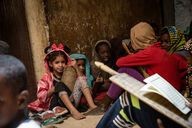
Baba El Hadj, a young schoolboy in Timbuktu, Mali.
Nicolas Réméné / Le Pictorium
LePictorium_0280416.jpg
The Koranic school (Medersa) Cheick Bashir Mohamed Lemine. The school offers traditional Muslim religious education to about 180 young schoolchildren in the Djingareyber district of Timbuktu, not far from the famous mosque of the same name. Portrait of Baba El Hadj, a schoolboy in Timbuktu. Baba El Hadj Sidi Ahmed, 14, lives with his uncle Baba Moulaye Al Arby in the Djingareyber neighbourhood, not far from the famous mosque of the same name. His uncle is also the marabout of the Koranic school (Medersa) Cheick Bashir Mohamed Lemine created by his grandfather, which is adjacent to the family home and offers a traditional Muslim religious education. It is here that Baba El Hadj learns every morning to read, write and memorise the Koran in Arabic. The medersa currently accommodates about 180 young schoolchildren. At lunchtime, Baba El Hadj often eats at his uncle's house where one of his aunts, Yaya Baba, prepares Timbuktu specialities such as toukassou or widjila, before returning to the Yehia Alkaya Ibrahim secondary school. On average, Baba El Hadj spends 4 hours a day at the medersa and then 6 hours at the basic school where he studies general subjects such as French, history-geography, civic and moral education, English, mathematics and science. For the past year, two or three times a week after school, Baba El Hadj has been attending calligraphy classes with his teacher Boubacar Sadek at the Arts et Métiers workshop devoted to copyists applied to manuscripts. He would like to make a living out of it one day and copy ancient manuscripts.
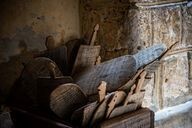
Baba El Hadj, a young schoolboy in Timbuktu, Mali.
Nicolas Réméné / Le Pictorium
LePictorium_0280417.jpg
Koranic tablets used to write down verses from the Koran but also religious texts of different natures. The Koranic school (Medersa) Cheick Bashir Mohamed Lemine. The school offers traditional Muslim religious education to about 180 young schoolchildren in the Djingareyber district of Timbuktu, not far from the famous mosque of the same name. Portrait of Baba El Hadj, a schoolboy in Timbuktu. Baba El Hadj Sidi Ahmed, 14, lives with his uncle Baba Moulaye Al Arby in the Djingareyber neighbourhood, not far from the famous mosque of the same name. His uncle is also the marabout of the Koranic school (Medersa) Cheick Bashir Mohamed Lemine created by his grandfather, which is adjacent to the family home and offers a traditional Muslim religious education. It is here that Baba El Hadj learns every morning to read, write and memorise the Koran in Arabic. The medersa currently accommodates about 180 young schoolchildren. At lunchtime, Baba El Hadj often eats at his uncle's house where one of his aunts, Yaya Baba, prepares Timbuktu specialities such as toukassou or widjila, before returning to the Yehia Alkaya Ibrahim secondary school. On average, Baba El Hadj spends 4 hours a day at the medersa and then 6 hours at the basic school where he studies general subjects such as French, history-geography, civic and moral education, English, mathematics and science. For the past year, two or three times a week after school, Baba El Hadj has been attending calligraphy classes with his teacher Boubacar Sadek at the Arts et Métiers workshop devoted to copyists applied to manuscripts. He would like to make a living out of it one day and copy ancient manuscripts.
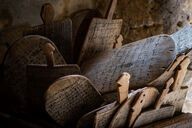
Baba El Hadj, a young schoolboy in Timbuktu, Mali.
Nicolas Réméné / Le Pictorium
LePictorium_0280418.jpg
Koranic tablets used to write down verses from the Koran but also religious texts of different natures. The Koranic school (Medersa) Cheick Bashir Mohamed Lemine. The school offers traditional Muslim religious education to about 180 young schoolchildren in the Djingareyber district of Timbuktu, not far from the famous mosque of the same name. Portrait of Baba El Hadj, a schoolboy in Timbuktu. Baba El Hadj Sidi Ahmed, 14, lives with his uncle Baba Moulaye Al Arby in the Djingareyber neighbourhood, not far from the famous mosque of the same name. His uncle is also the marabout of the Koranic school (Medersa) Cheick Bashir Mohamed Lemine created by his grandfather, which is adjacent to the family home and offers a traditional Muslim religious education. It is here that Baba El Hadj learns every morning to read, write and memorise the Koran in Arabic. The medersa currently accommodates about 180 young schoolchildren. At lunchtime, Baba El Hadj often eats at his uncle's house where one of his aunts, Yaya Baba, prepares Timbuktu specialities such as toukassou or widjila, before returning to the Yehia Alkaya Ibrahim secondary school. On average, Baba El Hadj spends 4 hours a day at the medersa and then 6 hours at the basic school where he studies general subjects such as French, history-geography, civic and moral education, English, mathematics and science. For the past year, two or three times a week after school, Baba El Hadj has been attending calligraphy classes with his teacher Boubacar Sadek at the Arts et Métiers workshop devoted to copyists applied to manuscripts. He would like to make a living out of it one day and copy ancient manuscripts.
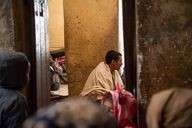
Baba El Hadj, a young schoolboy in Timbuktu, Mali.
Nicolas Réméné / Le Pictorium
LePictorium_0280419.jpg
The Koranic school (Medersa) Cheick Bashir Mohamed Lemine. The school offers traditional Muslim religious education to about 180 young schoolchildren in the Djingareyber district of Timbuktu, not far from the famous mosque of the same name. Portrait of Baba El Hadj, a schoolboy in Timbuktu. Baba El Hadj Sidi Ahmed, 14, lives with his uncle Baba Moulaye Al Arby in the Djingareyber neighbourhood, not far from the famous mosque of the same name. His uncle is also the marabout of the Koranic school (Medersa) Cheick Bashir Mohamed Lemine created by his grandfather, which is adjacent to the family home and offers a traditional Muslim religious education. It is here that Baba El Hadj learns every morning to read, write and memorise the Koran in Arabic. The medersa currently accommodates about 180 young schoolchildren. At lunchtime, Baba El Hadj often eats at his uncle's house where one of his aunts, Yaya Baba, prepares Timbuktu specialities such as toukassou or widjila, before returning to the Yehia Alkaya Ibrahim secondary school. On average, Baba El Hadj spends 4 hours a day at the medersa and then 6 hours at the basic school where he studies general subjects such as French, history-geography, civic and moral education, English, mathematics and science. For the past year, two or three times a week after school, Baba El Hadj has been attending calligraphy classes with his teacher Boubacar Sadek at the Arts et Métiers workshop devoted to copyists applied to manuscripts. He would like to make a living out of it one day and copy ancient manuscripts.
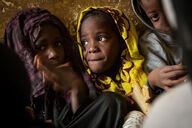
Baba El Hadj, a young schoolboy in Timbuktu, Mali.
Nicolas Réméné / Le Pictorium
LePictorium_0280420.jpg
The Koranic school (Medersa) Cheick Bashir Mohamed Lemine. The school offers traditional Muslim religious education to about 180 young schoolchildren in the Djingareyber district of Timbuktu, not far from the famous mosque of the same name. Portrait of Baba El Hadj, a schoolboy in Timbuktu. Baba El Hadj Sidi Ahmed, 14, lives with his uncle Baba Moulaye Al Arby in the Djingareyber neighbourhood, not far from the famous mosque of the same name. His uncle is also the marabout of the Koranic school (Medersa) Cheick Bashir Mohamed Lemine created by his grandfather, which is adjacent to the family home and offers a traditional Muslim religious education. It is here that Baba El Hadj learns every morning to read, write and memorise the Koran in Arabic. The medersa currently accommodates about 180 young schoolchildren. At lunchtime, Baba El Hadj often eats at his uncle's house where one of his aunts, Yaya Baba, prepares Timbuktu specialities such as toukassou or widjila, before returning to the Yehia Alkaya Ibrahim secondary school. On average, Baba El Hadj spends 4 hours a day at the medersa and then 6 hours at the basic school where he studies general subjects such as French, history-geography, civic and moral education, English, mathematics and science. For the past year, two or three times a week after school, Baba El Hadj has been attending calligraphy classes with his teacher Boubacar Sadek at the Arts et Métiers workshop devoted to copyists applied to manuscripts. He would like to make a living out of it one day and copy ancient manuscripts.
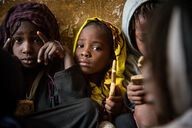
Baba El Hadj, a young schoolboy in Timbuktu, Mali.
Nicolas Réméné / Le Pictorium
LePictorium_0280421.jpg
The Koranic school (Medersa) Cheick Bashir Mohamed Lemine. The school offers traditional Muslim religious education to about 180 young schoolchildren in the Djingareyber district of Timbuktu, not far from the famous mosque of the same name. Portrait of Baba El Hadj, a schoolboy in Timbuktu. Baba El Hadj Sidi Ahmed, 14, lives with his uncle Baba Moulaye Al Arby in the Djingareyber neighbourhood, not far from the famous mosque of the same name. His uncle is also the marabout of the Koranic school (Medersa) Cheick Bashir Mohamed Lemine created by his grandfather, which is adjacent to the family home and offers a traditional Muslim religious education. It is here that Baba El Hadj learns every morning to read, write and memorise the Koran in Arabic. The medersa currently accommodates about 180 young schoolchildren. At lunchtime, Baba El Hadj often eats at his uncle's house where one of his aunts, Yaya Baba, prepares Timbuktu specialities such as toukassou or widjila, before returning to the Yehia Alkaya Ibrahim secondary school. On average, Baba El Hadj spends 4 hours a day at the medersa and then 6 hours at the basic school where he studies general subjects such as French, history-geography, civic and moral education, English, mathematics and science. For the past year, two or three times a week after school, Baba El Hadj has been attending calligraphy classes with his teacher Boubacar Sadek at the Arts et Métiers workshop devoted to copyists applied to manuscripts. He would like to make a living out of it one day and copy ancient manuscripts.
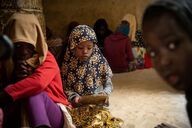
Baba El Hadj, a young schoolboy in Timbuktu, Mali.
Nicolas Réméné / Le Pictorium
LePictorium_0280422.jpg
The Koranic school (Medersa) Cheick Bashir Mohamed Lemine. The school offers traditional Muslim religious education to about 180 young schoolchildren in the Djingareyber district of Timbuktu, not far from the famous mosque of the same name. Portrait of Baba El Hadj, a schoolboy in Timbuktu. Baba El Hadj Sidi Ahmed, 14, lives with his uncle Baba Moulaye Al Arby in the Djingareyber neighbourhood, not far from the famous mosque of the same name. His uncle is also the marabout of the Koranic school (Medersa) Cheick Bashir Mohamed Lemine created by his grandfather, which is adjacent to the family home and offers a traditional Muslim religious education. It is here that Baba El Hadj learns every morning to read, write and memorise the Koran in Arabic. The medersa currently accommodates about 180 young schoolchildren. At lunchtime, Baba El Hadj often eats at his uncle's house where one of his aunts, Yaya Baba, prepares Timbuktu specialities such as toukassou or widjila, before returning to the Yehia Alkaya Ibrahim secondary school. On average, Baba El Hadj spends 4 hours a day at the medersa and then 6 hours at the basic school where he studies general subjects such as French, history-geography, civic and moral education, English, mathematics and science. For the past year, two or three times a week after school, Baba El Hadj has been attending calligraphy classes with his teacher Boubacar Sadek at the Arts et Métiers workshop devoted to copyists applied to manuscripts. He would like to make a living out of it one day and copy ancient manuscripts.
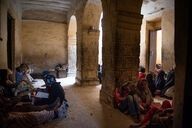
Baba El Hadj, a young schoolboy in Timbuktu, Mali.
Nicolas Réméné / Le Pictorium
LePictorium_0280423.jpg
The Koranic school (Medersa) Cheick Bashir Mohamed Lemine. The school offers traditional Muslim religious education to about 180 young schoolchildren in the Djingareyber district of Timbuktu, not far from the famous mosque of the same name. Portrait of Baba El Hadj, a schoolboy in Timbuktu. Baba El Hadj Sidi Ahmed, 14, lives with his uncle Baba Moulaye Al Arby in the Djingareyber neighbourhood, not far from the famous mosque of the same name. His uncle is also the marabout of the Koranic school (Medersa) Cheick Bashir Mohamed Lemine created by his grandfather, which is adjacent to the family home and offers a traditional Muslim religious education. It is here that Baba El Hadj learns every morning to read, write and memorise the Koran in Arabic. The medersa currently accommodates about 180 young schoolchildren. At lunchtime, Baba El Hadj often eats at his uncle's house where one of his aunts, Yaya Baba, prepares Timbuktu specialities such as toukassou or widjila, before returning to the Yehia Alkaya Ibrahim secondary school. On average, Baba El Hadj spends 4 hours a day at the medersa and then 6 hours at the basic school where he studies general subjects such as French, history-geography, civic and moral education, English, mathematics and science. For the past year, two or three times a week after school, Baba El Hadj has been attending calligraphy classes with his teacher Boubacar Sadek at the Arts et Métiers workshop devoted to copyists applied to manuscripts. He would like to make a living out of it one day and copy ancient manuscripts.
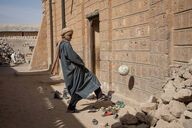
Baba El Hadj, a young schoolboy in Timbuktu, Mali.
Nicolas Réméné / Le Pictorium
LePictorium_0280424.jpg
Boubacar Sadek, a calligraphy teacher and former student of the Koranic school (Medersa) Cheick Bashir Mohamed Lemine, plays football in the Djingareyber district of Timbuktu, not far from the famous mosque of the same name. Portrait of Baba El Hadj, a schoolboy in Timbuktu. Baba El Hadj Sidi Ahmed, 14, lives with his uncle Baba Moulaye Al Arby in the Djingareyber neighbourhood, not far from the famous mosque of the same name. His uncle is also the marabout of the Koranic school (Medersa) Cheick Bashir Mohamed Lemine created by his grandfather, which is adjacent to the family home and offers a traditional Muslim religious education. It is here that Baba El Hadj learns every morning to read, write and memorise the Koran in Arabic. The medersa currently accommodates about 180 young schoolchildren. At lunchtime, Baba El Hadj often eats at his uncle's house where one of his aunts, Yaya Baba, prepares Timbuktu specialities such as toukassou or widjila, before returning to the Yehia Alkaya Ibrahim secondary school. On average, Baba El Hadj spends 4 hours a day at the medersa and then 6 hours at the basic school where he studies general subjects such as French, history-geography, civic and moral education, English, mathematics and science. For the past year, two or three times a week after school, Baba El Hadj has been attending calligraphy classes with his teacher Boubacar Sadek at the Arts et Métiers workshop devoted to copyists applied to manuscripts. He would like to make a living out of it one day and copy ancient manuscripts.

Baba El Hadj, a young schoolboy in Timbuktu, Mali.
Nicolas Réméné / Le Pictorium
LePictorium_0280425.jpg
Children and schoolchildren from the Koranic school (Medersa) Cheick Bashir Mohamed Lemine, play football in the Djingareyber district of Timbuktu, not far from the famous mosque of the same name. Portrait of Baba El Hadj, a schoolboy in Timbuktu. Baba El Hadj Sidi Ahmed, 14, lives with his uncle Baba Moulaye Al Arby in the Djingareyber neighbourhood, not far from the famous mosque of the same name. His uncle is also the marabout of the Koranic school (Medersa) Cheick Bashir Mohamed Lemine created by his grandfather, which is adjacent to the family home and offers a traditional Muslim religious education. It is here that Baba El Hadj learns every morning to read, write and memorise the Koran in Arabic. The medersa currently accommodates about 180 young schoolchildren. At lunchtime, Baba El Hadj often eats at his uncle's house where one of his aunts, Yaya Baba, prepares Timbuktu specialities such as toukassou or widjila, before returning to the Yehia Alkaya Ibrahim secondary school. On average, Baba El Hadj spends 4 hours a day at the medersa and then 6 hours at the basic school where he studies general subjects such as French, history-geography, civic and moral education, English, mathematics and science. For the past year, two or three times a week after school, Baba El Hadj has been attending calligraphy classes with his teacher Boubacar Sadek at the Arts et Métiers workshop devoted to copyists applied to manuscripts. He would like to make a living out of it one day and copy ancient manuscripts.
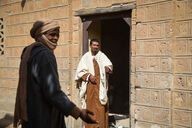
Baba El Hadj, a young schoolboy in Timbuktu, Mali.
Nicolas Réméné / Le Pictorium
LePictorium_0280426.jpg
Baba Moulaye Al Arby is the marabout of the Koranic school (Medersa) Cheick Bashir Mohamed Lemine in the Djingareyber district of Timbuktu. Created by his grandfather, and adjacent to the family home, the medersa offers traditional Muslim religious education. The medersa currently accommodates about 180 young schoolchildren. Portrait of Baba El Hadj, a schoolboy in Timbuktu. Baba El Hadj Sidi Ahmed, 14, lives with his uncle Baba Moulaye Al Arby in the Djingareyber neighbourhood, not far from the famous mosque of the same name. His uncle is also the marabout of the Koranic school (Medersa) Cheick Bashir Mohamed Lemine created by his grandfather, which is adjacent to the family home and offers a traditional Muslim religious education. It is here that Baba El Hadj learns every morning to read, write and memorise the Koran in Arabic. The medersa currently accommodates about 180 young schoolchildren. At lunchtime, Baba El Hadj often eats at his uncle's house where one of his aunts, Yaya Baba, prepares Timbuktu specialities such as toukassou or widjila, before returning to the Yehia Alkaya Ibrahim secondary school. On average, Baba El Hadj spends 4 hours a day at the medersa and then 6 hours at the basic school where he studies general subjects such as French, history-geography, civic and moral education, English, mathematics and science. For the past year, two or three times a week after school, Baba El Hadj has been attending calligraphy classes with his teacher Boubacar Sadek at the Arts et Métiers workshop devoted to copyists applied to manuscripts. He would like to make a living out of it one day and copy ancient manuscripts.
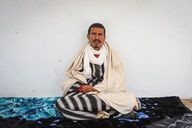
Baba El Hadj, a young schoolboy in Timbuktu, Mali.
Nicolas Réméné / Le Pictorium
LePictorium_0280427.jpg
Baba Moulaye Al Arby is the marabout of the Koranic school (Medersa) Cheick Bashir Mohamed Lemine in the Djingareyber district of Timbuktu. Created by his grandfather, and adjacent to the family home, the medersa offers traditional Muslim religious education. The medersa currently accommodates about 180 young schoolchildren. Portrait of Baba El Hadj, a schoolboy in Timbuktu. Baba El Hadj Sidi Ahmed, 14, lives with his uncle Baba Moulaye Al Arby in the Djingareyber neighbourhood, not far from the famous mosque of the same name. His uncle is also the marabout of the Koranic school (Medersa) Cheick Bashir Mohamed Lemine created by his grandfather, which is adjacent to the family home and offers a traditional Muslim religious education. It is here that Baba El Hadj learns every morning to read, write and memorise the Koran in Arabic. The medersa currently accommodates about 180 young schoolchildren. At lunchtime, Baba El Hadj often eats at his uncle's house where one of his aunts, Yaya Baba, prepares Timbuktu specialities such as toukassou or widjila, before returning to the Yehia Alkaya Ibrahim secondary school. On average, Baba El Hadj spends 4 hours a day at the medersa and then 6 hours at the basic school where he studies general subjects such as French, history-geography, civic and moral education, English, mathematics and science. For the past year, two or three times a week after school, Baba El Hadj has been attending calligraphy classes with his teacher Boubacar Sadek at the Arts et Métiers workshop devoted to copyists applied to manuscripts. He would like to make a living out of it one day and copy ancient manuscripts.
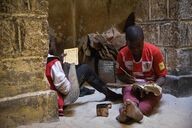
Baba El Hadj, a young schoolboy in Timbuktu, Mali.
Nicolas Réméné / Le Pictorium
LePictorium_0280428.jpg
The Koranic school (Medersa) Cheick Bashir Mohamed Lemine. The school offers traditional Muslim religious education to about 180 young schoolchildren in the Djingareyber district of Timbuktu, not far from the famous mosque of the same name. Portrait of Baba El Hadj, a schoolboy in Timbuktu. Baba El Hadj Sidi Ahmed, 14, lives with his uncle Baba Moulaye Al Arby in the Djingareyber neighbourhood, not far from the famous mosque of the same name. His uncle is also the marabout of the Koranic school (Medersa) Cheick Bashir Mohamed Lemine created by his grandfather, which is adjacent to the family home and offers a traditional Muslim religious education. It is here that Baba El Hadj learns every morning to read, write and memorise the Koran in Arabic. The medersa currently accommodates about 180 young schoolchildren. At lunchtime, Baba El Hadj often eats at his uncle's house where one of his aunts, Yaya Baba, prepares Timbuktu specialities such as toukassou or widjila, before returning to the Yehia Alkaya Ibrahim secondary school. On average, Baba El Hadj spends 4 hours a day at the medersa and then 6 hours at the basic school where he studies general subjects such as French, history-geography, civic and moral education, English, mathematics and science. For the past year, two or three times a week after school, Baba El Hadj has been attending calligraphy classes with his teacher Boubacar Sadek at the Arts et Métiers workshop devoted to copyists applied to manuscripts. He would like to make a living out of it one day and copy ancient manuscripts.
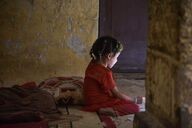
Baba El Hadj, a young schoolboy in Timbuktu, Mali.
Nicolas Réméné / Le Pictorium
LePictorium_0280429.jpg
The Koranic school (Medersa) Cheick Bashir Mohamed Lemine. The school offers traditional Muslim religious education to about 180 young schoolchildren in the Djingareyber district of Timbuktu, not far from the famous mosque of the same name. Portrait of Baba El Hadj, a schoolboy in Timbuktu. Baba El Hadj Sidi Ahmed, 14, lives with his uncle Baba Moulaye Al Arby in the Djingareyber neighbourhood, not far from the famous mosque of the same name. His uncle is also the marabout of the Koranic school (Medersa) Cheick Bashir Mohamed Lemine created by his grandfather, which is adjacent to the family home and offers a traditional Muslim religious education. It is here that Baba El Hadj learns every morning to read, write and memorise the Koran in Arabic. The medersa currently accommodates about 180 young schoolchildren. At lunchtime, Baba El Hadj often eats at his uncle's house where one of his aunts, Yaya Baba, prepares Timbuktu specialities such as toukassou or widjila, before returning to the Yehia Alkaya Ibrahim secondary school. On average, Baba El Hadj spends 4 hours a day at the medersa and then 6 hours at the basic school where he studies general subjects such as French, history-geography, civic and moral education, English, mathematics and science. For the past year, two or three times a week after school, Baba El Hadj has been attending calligraphy classes with his teacher Boubacar Sadek at the Arts et Métiers workshop devoted to copyists applied to manuscripts. He would like to make a living out of it one day and copy ancient manuscripts.
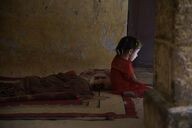
Baba El Hadj, a young schoolboy in Timbuktu, Mali.
Nicolas Réméné / Le Pictorium
LePictorium_0280430.jpg
The Koranic school (Medersa) Cheick Bashir Mohamed Lemine. The school offers traditional Muslim religious education to about 180 young schoolchildren in the Djingareyber district of Timbuktu, not far from the famous mosque of the same name. Portrait of Baba El Hadj, a schoolboy in Timbuktu. Baba El Hadj Sidi Ahmed, 14, lives with his uncle Baba Moulaye Al Arby in the Djingareyber neighbourhood, not far from the famous mosque of the same name. His uncle is also the marabout of the Koranic school (Medersa) Cheick Bashir Mohamed Lemine created by his grandfather, which is adjacent to the family home and offers a traditional Muslim religious education. It is here that Baba El Hadj learns every morning to read, write and memorise the Koran in Arabic. The medersa currently accommodates about 180 young schoolchildren. At lunchtime, Baba El Hadj often eats at his uncle's house where one of his aunts, Yaya Baba, prepares Timbuktu specialities such as toukassou or widjila, before returning to the Yehia Alkaya Ibrahim secondary school. On average, Baba El Hadj spends 4 hours a day at the medersa and then 6 hours at the basic school where he studies general subjects such as French, history-geography, civic and moral education, English, mathematics and science. For the past year, two or three times a week after school, Baba El Hadj has been attending calligraphy classes with his teacher Boubacar Sadek at the Arts et Métiers workshop devoted to copyists applied to manuscripts. He would like to make a living out of it one day and copy ancient manuscripts.
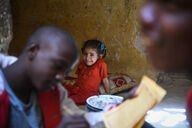
Baba El Hadj, a young schoolboy in Timbuktu, Mali.
Nicolas Réméné / Le Pictorium
LePictorium_0280431.jpg
The Koranic school (Medersa) Cheick Bashir Mohamed Lemine. The school offers traditional Muslim religious education to about 180 young schoolchildren in the Djingareyber district of Timbuktu, not far from the famous mosque of the same name. Portrait of Baba El Hadj, a schoolboy in Timbuktu. Baba El Hadj Sidi Ahmed, 14, lives with his uncle Baba Moulaye Al Arby in the Djingareyber neighbourhood, not far from the famous mosque of the same name. His uncle is also the marabout of the Koranic school (Medersa) Cheick Bashir Mohamed Lemine created by his grandfather, which is adjacent to the family home and offers a traditional Muslim religious education. It is here that Baba El Hadj learns every morning to read, write and memorise the Koran in Arabic. The medersa currently accommodates about 180 young schoolchildren. At lunchtime, Baba El Hadj often eats at his uncle's house where one of his aunts, Yaya Baba, prepares Timbuktu specialities such as toukassou or widjila, before returning to the Yehia Alkaya Ibrahim secondary school. On average, Baba El Hadj spends 4 hours a day at the medersa and then 6 hours at the basic school where he studies general subjects such as French, history-geography, civic and moral education, English, mathematics and science. For the past year, two or three times a week after school, Baba El Hadj has been attending calligraphy classes with his teacher Boubacar Sadek at the Arts et Métiers workshop devoted to copyists applied to manuscripts. He would like to make a living out of it one day and copy ancient manuscripts.

Baba El Hadj, a young schoolboy in Timbuktu, Mali.
Nicolas Réméné / Le Pictorium
LePictorium_0280432.jpg
The Koranic school (Medersa) Cheick Bashir Mohamed Lemine. The school offers traditional Muslim religious education to about 180 young schoolchildren in the Djingareyber district of Timbuktu, not far from the famous mosque of the same name. Portrait of Baba El Hadj, a schoolboy in Timbuktu. Baba El Hadj Sidi Ahmed, 14, lives with his uncle Baba Moulaye Al Arby in the Djingareyber neighbourhood, not far from the famous mosque of the same name. His uncle is also the marabout of the Koranic school (Medersa) Cheick Bashir Mohamed Lemine created by his grandfather, which is adjacent to the family home and offers a traditional Muslim religious education. It is here that Baba El Hadj learns every morning to read, write and memorise the Koran in Arabic. The medersa currently accommodates about 180 young schoolchildren. At lunchtime, Baba El Hadj often eats at his uncle's house where one of his aunts, Yaya Baba, prepares Timbuktu specialities such as toukassou or widjila, before returning to the Yehia Alkaya Ibrahim secondary school. On average, Baba El Hadj spends 4 hours a day at the medersa and then 6 hours at the basic school where he studies general subjects such as French, history-geography, civic and moral education, English, mathematics and science. For the past year, two or three times a week after school, Baba El Hadj has been attending calligraphy classes with his teacher Boubacar Sadek at the Arts et Métiers workshop devoted to copyists applied to manuscripts. He would like to make a living out of it one day and copy ancient manuscripts.
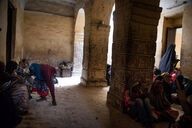
Baba El Hadj, a young schoolboy in Timbuktu, Mali.
Nicolas Réméné / Le Pictorium
LePictorium_0280433.jpg
The Koranic school (Medersa) Cheick Bashir Mohamed Lemine. The school offers traditional Muslim religious education to about 180 young schoolchildren in the Djingareyber district of Timbuktu, not far from the famous mosque of the same name. Portrait of Baba El Hadj, a schoolboy in Timbuktu. Baba El Hadj Sidi Ahmed, 14, lives with his uncle Baba Moulaye Al Arby in the Djingareyber neighbourhood, not far from the famous mosque of the same name. His uncle is also the marabout of the Koranic school (Medersa) Cheick Bashir Mohamed Lemine created by his grandfather, which is adjacent to the family home and offers a traditional Muslim religious education. It is here that Baba El Hadj learns every morning to read, write and memorise the Koran in Arabic. The medersa currently accommodates about 180 young schoolchildren. At lunchtime, Baba El Hadj often eats at his uncle's house where one of his aunts, Yaya Baba, prepares Timbuktu specialities such as toukassou or widjila, before returning to the Yehia Alkaya Ibrahim secondary school. On average, Baba El Hadj spends 4 hours a day at the medersa and then 6 hours at the basic school where he studies general subjects such as French, history-geography, civic and moral education, English, mathematics and science. For the past year, two or three times a week after school, Baba El Hadj has been attending calligraphy classes with his teacher Boubacar Sadek at the Arts et Métiers workshop devoted to copyists applied to manuscripts. He would like to make a living out of it one day and copy ancient manuscripts.
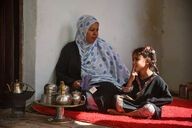
Baba El Hadj, a young schoolboy in Timbuktu, Mali.
Nicolas Réméné / Le Pictorium
LePictorium_0280434.jpg
Baba El Hadj's aunt, with her two daughters, prepares tea for the family. His brother Baba Moulaye Al Arby is the marabout of the Koranic school (Medersa) Cheick Bashir Mohamed Lemine, which was created by his grandfather, and which is adjacent to the family home. The school offers traditional Muslim religious education to around 180 young schoolchildren in the Djingareyber district of Timbuktu, not far from the famous mosque of the same name. Portrait of Baba El Hadj, a schoolboy in Timbuktu. Baba El Hadj Sidi Ahmed, 14, lives with his uncle Baba Moulaye Al Arby in the Djingareyber neighbourhood, not far from the famous mosque of the same name. His uncle is also the marabout of the Koranic school (Medersa) Cheick Bashir Mohamed Lemine created by his grandfather, which is adjacent to the family home and offers a traditional Muslim religious education. It is here that Baba El Hadj learns every morning to read, write and memorise the Koran in Arabic. The medersa currently accommodates about 180 young schoolchildren. At lunchtime, Baba El Hadj often eats at his uncle's house where one of his aunts, Yaya Baba, prepares Timbuktu specialities such as toukassou or widjila, before returning to the Yehia Alkaya Ibrahim secondary school. On average, Baba El Hadj spends 4 hours a day at the medersa and then 6 hours at the basic school where he studies general subjects such as French, history-geography, civic and moral education, English, mathematics and science. For the past year, two or three times a week after school, Baba El Hadj has been attending calligraphy classes with his teacher Boubacar Sadek at the Arts et Métiers workshop devoted to copyists applied to manuscripts. He would like to make a living out of it one day and copy ancient manuscripts.
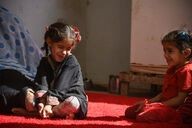
Baba El Hadj, a young schoolboy in Timbuktu, Mali.
Nicolas Réméné / Le Pictorium
LePictorium_0280435.jpg
Timbuktu, Mali, 18 January 2020. Portrait of Baba El Hadj, a schoolboy in Timbuktu. Baba El Hadj Sidi Ahmed, 14, lives with his uncle Baba Moulaye Al Arby in the Djingareyber neighbourhood, not far from the famous mosque of the same name. His uncle is also the marabout of the Koranic school (Medersa) Cheick Bashir Mohamed Lemine created by his grandfather, which is adjacent to the family home and offers traditional Muslim religious education. It is here that Baba El Hadj learns every morning to read, write and memorise the Koran in Arabic. The medersa currently accommodates about 180 young schoolchildren. At lunchtime, Baba El Hadj often eats at his uncle's house where one of his aunts, Yaya Baba, prepares Timbuktu specialities such as toukassou or widjila, before returning to the Yehia Alkaya Ibrahim secondary school. On average, Baba El Hadj spends 4 hours a day at the medersa and then 6 hours at the basic school where he studies general subjects such as French, history-geography, civic and moral education, English, mathematics and science. For the past year, two or three times a week after school, Baba El Hadj has been attending calligraphy classes with his teacher Boubacar Sadek at the Arts et Métiers workshop devoted to copyists applied to manuscripts. He would like to make a living out of it one day and copy ancient manuscripts.
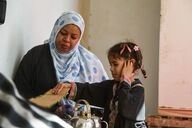
Baba El Hadj, a young schoolboy in Timbuktu, Mali.
Nicolas Réméné / Le Pictorium
LePictorium_0280436.jpg
Timbuktu, Mali, 18 January 2020. Portrait of Baba El Hadj, a schoolboy in Timbuktu. Baba El Hadj Sidi Ahmed, 14, lives with his uncle Baba Moulaye Al Arby in the Djingareyber neighbourhood, not far from the famous mosque of the same name. His uncle is also the marabout of the Koranic school (Medersa) Cheick Bashir Mohamed Lemine created by his grandfather, which is adjacent to the family home and offers traditional Muslim religious education. It is here that Baba El Hadj learns every morning to read, write and memorise the Koran in Arabic. The medersa currently accommodates about 180 young schoolchildren. At lunchtime, Baba El Hadj often eats at his uncle's house where one of his aunts, Yaya Baba, prepares Timbuktu specialities such as toukassou or widjila, before returning to the Yehia Alkaya Ibrahim secondary school. On average, Baba El Hadj spends 4 hours a day at the medersa and then 6 hours at the basic school where he studies general subjects such as French, history-geography, civic and moral education, English, mathematics and science. For the past year, two or three times a week after school, Baba El Hadj has been attending calligraphy classes with his teacher Boubacar Sadek at the Arts et Métiers workshop devoted to copyists applied to manuscripts. He would like to make a living out of it one day and copy ancient manuscripts.
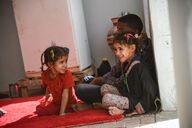
Baba El Hadj, a young schoolboy in Timbuktu, Mali.
Nicolas Réméné / Le Pictorium
LePictorium_0280437.jpg
Timbuktu, Mali, 18 January 2020. Portrait of Baba El Hadj, a schoolboy in Timbuktu. Baba El Hadj Sidi Ahmed, 14, lives with his uncle Baba Moulaye Al Arby in the Djingareyber neighbourhood, not far from the famous mosque of the same name. His uncle is also the marabout of the Koranic school (Medersa) Cheick Bashir Mohamed Lemine created by his grandfather, which is adjacent to the family home and offers traditional Muslim religious education. It is here that Baba El Hadj learns every morning to read, write and memorise the Koran in Arabic. The medersa currently accommodates about 180 young schoolchildren. At lunchtime, Baba El Hadj often eats at his uncle's house where one of his aunts, Yaya Baba, prepares Timbuktu specialities such as toukassou or widjila, before returning to the Yehia Alkaya Ibrahim secondary school. On average, Baba El Hadj spends 4 hours a day at the medersa and then 6 hours at the basic school where he studies general subjects such as French, history-geography, civic and moral education, English, mathematics and science. For the past year, two or three times a week after school, Baba El Hadj has been attending calligraphy classes with his teacher Boubacar Sadek at the Arts et Métiers workshop devoted to copyists applied to manuscripts. He would like to make a living out of it one day and copy ancient manuscripts.
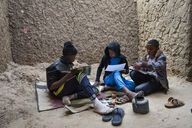
Baba El Hadj, a young schoolboy in Timbuktu, Mali.
Nicolas Réméné / Le Pictorium
LePictorium_0280438.jpg
For the past year, two or three times a week after school, Baba El Hadj has been attending calligraphy classes with his teacher Boubacar Sadek at the Arts et Métiers workshop for manuscript copyists. The workshop is also located in the Djingareyber district, not far from the famous mosque of the same name in Timbuktu. He would like to make a living out of it one day and copy ancient manuscripts. Portrait of Baba El Hadj, a schoolboy in Timbuktu. Baba El Hadj Sidi Ahmed, 14, lives with his uncle Baba Moulaye Al Arby in the Djingareyber neighbourhood, not far from the famous mosque of the same name. His uncle is also the marabout of the Koranic school (Medersa) Cheick Bashir Mohamed Lemine created by his grandfather, which is adjacent to the family home and offers a traditional Muslim religious education. It is here that Baba El Hadj learns every morning to read, write and memorise the Koran in Arabic. The medersa currently accommodates about 180 young schoolchildren. At lunchtime, Baba El Hadj often eats at his uncle's house where one of his aunts, Yaya Baba, prepares Timbuktu specialities such as toukassou or widjila, before returning to the Yehia Alkaya Ibrahim secondary school. On average, Baba El Hadj spends 4 hours a day at the medersa and then 6 hours at the basic school where he studies general subjects such as French, history-geography, civic and moral education, English, mathematics and science. For the past year, two or three times a week after school, Baba El Hadj has been attending calligraphy classes with his teacher Boubacar Sadek at the Arts et Métiers workshop devoted to copyists applied to manuscripts. He would like to make a living out of it one day and copy ancient manuscripts.
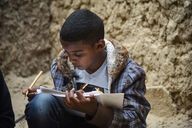
Baba El Hadj, a young schoolboy in Timbuktu, Mali.
Nicolas Réméné / Le Pictorium
LePictorium_0280439.jpg
For the past year, two or three times a week after school, Baba El Hadj has been attending calligraphy classes with his teacher Boubacar Sadek at the Arts et Métiers workshop for manuscript copyists. The workshop is also located in the Djingareyber district, not far from the famous mosque of the same name in Timbuktu. He would like to make a living out of it one day and copy ancient manuscripts. Portrait of Baba El Hadj, a schoolboy in Timbuktu. Baba El Hadj Sidi Ahmed, 14, lives with his uncle Baba Moulaye Al Arby in the Djingareyber neighbourhood, not far from the famous mosque of the same name. His uncle is also the marabout of the Koranic school (Medersa) Cheick Bashir Mohamed Lemine created by his grandfather, which is adjacent to the family home and offers a traditional Muslim religious education. It is here that Baba El Hadj learns every morning to read, write and memorise the Koran in Arabic. The medersa currently accommodates about 180 young schoolchildren. At lunchtime, Baba El Hadj often eats at his uncle's house where one of his aunts, Yaya Baba, prepares Timbuktu specialities such as toukassou or widjila, before returning to the Yehia Alkaya Ibrahim secondary school. On average, Baba El Hadj spends 4 hours a day at the medersa and then 6 hours at the basic school where he studies general subjects such as French, history-geography, civic and moral education, English, mathematics and science. For the past year, two or three times a week after school, Baba El Hadj has been attending calligraphy classes with his teacher Boubacar Sadek at the Arts et Métiers workshop devoted to copyists applied to manuscripts. He would like to make a living out of it one day and copy ancient manuscripts.
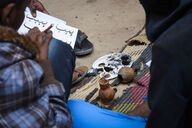
Baba El Hadj, a young schoolboy in Timbuktu, Mali.
Nicolas Réméné / Le Pictorium
LePictorium_0280440.jpg
For the past year, two or three times a week after school, Baba El Hadj has been attending calligraphy classes with his teacher Boubacar Sadek at the Arts et Métiers workshop for manuscript copyists. The workshop is also located in the Djingareyber district, not far from the famous mosque of the same name in Timbuktu. He would like to make a living out of it one day and copy ancient manuscripts. Portrait of Baba El Hadj, a schoolboy in Timbuktu. Baba El Hadj Sidi Ahmed, 14, lives with his uncle Baba Moulaye Al Arby in the Djingareyber neighbourhood, not far from the famous mosque of the same name. His uncle is also the marabout of the Koranic school (Medersa) Cheick Bashir Mohamed Lemine created by his grandfather, which is adjacent to the family home and offers a traditional Muslim religious education. It is here that Baba El Hadj learns every morning to read, write and memorise the Koran in Arabic. The medersa currently accommodates about 180 young schoolchildren. At lunchtime, Baba El Hadj often eats at his uncle's house where one of his aunts, Yaya Baba, prepares Timbuktu specialities such as toukassou or widjila, before returning to the Yehia Alkaya Ibrahim secondary school. On average, Baba El Hadj spends 4 hours a day at the medersa and then 6 hours at the basic school where he studies general subjects such as French, history-geography, civic and moral education, English, mathematics and science. For the past year, two or three times a week after school, Baba El Hadj has been attending calligraphy classes with his teacher Boubacar Sadek at the Arts et Métiers workshop devoted to copyists applied to manuscripts. He would like to make a living out of it one day and copy ancient manuscripts.
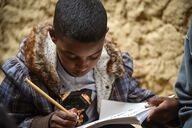
Baba El Hadj, a young schoolboy in Timbuktu, Mali.
Nicolas Réméné / Le Pictorium
LePictorium_0280441.jpg
For the past year, two or three times a week after school, Baba El Hadj has been attending calligraphy classes with his teacher Boubacar Sadek at the Arts et Métiers workshop for manuscript copyists. The workshop is also located in the Djingareyber district, not far from the famous mosque of the same name in Timbuktu. He would like to make a living out of it one day and copy ancient manuscripts. Portrait of Baba El Hadj, a schoolboy in Timbuktu. Baba El Hadj Sidi Ahmed, 14, lives with his uncle Baba Moulaye Al Arby in the Djingareyber neighbourhood, not far from the famous mosque of the same name. His uncle is also the marabout of the Koranic school (Medersa) Cheick Bashir Mohamed Lemine created by his grandfather, which is adjacent to the family home and offers a traditional Muslim religious education. It is here that Baba El Hadj learns every morning to read, write and memorise the Koran in Arabic. The medersa currently accommodates about 180 young schoolchildren. At lunchtime, Baba El Hadj often eats at his uncle's house where one of his aunts, Yaya Baba, prepares Timbuktu specialities such as toukassou or widjila, before returning to the Yehia Alkaya Ibrahim secondary school. On average, Baba El Hadj spends 4 hours a day at the medersa and then 6 hours at the basic school where he studies general subjects such as French, history-geography, civic and moral education, English, mathematics and science. For the past year, two or three times a week after school, Baba El Hadj has been attending calligraphy classes with his teacher Boubacar Sadek at the Arts et Métiers workshop devoted to copyists applied to manuscripts. He would like to make a living out of it one day and copy ancient manuscripts.
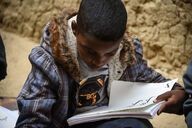
Baba El Hadj, a young schoolboy in Timbuktu, Mali.
Nicolas Réméné / Le Pictorium
LePictorium_0280442.jpg
For the past year, two or three times a week after school, Baba El Hadj has been attending calligraphy classes with his teacher Boubacar Sadek at the Arts et Métiers workshop for manuscript copyists. The workshop is also located in the Djingareyber district, not far from the famous mosque of the same name in Timbuktu. He would like to make a living out of it one day and copy ancient manuscripts. Portrait of Baba El Hadj, a schoolboy in Timbuktu. Baba El Hadj Sidi Ahmed, 14, lives with his uncle Baba Moulaye Al Arby in the Djingareyber neighbourhood, not far from the famous mosque of the same name. His uncle is also the marabout of the Koranic school (Medersa) Cheick Bashir Mohamed Lemine created by his grandfather, which is adjacent to the family home and offers a traditional Muslim religious education. It is here that Baba El Hadj learns every morning to read, write and memorise the Koran in Arabic. The medersa currently accommodates about 180 young schoolchildren. At lunchtime, Baba El Hadj often eats at his uncle's house where one of his aunts, Yaya Baba, prepares Timbuktu specialities such as toukassou or widjila, before returning to the Yehia Alkaya Ibrahim secondary school. On average, Baba El Hadj spends 4 hours a day at the medersa and then 6 hours at the basic school where he studies general subjects such as French, history-geography, civic and moral education, English, mathematics and science. For the past year, two or three times a week after school, Baba El Hadj has been attending calligraphy classes with his teacher Boubacar Sadek at the Arts et Métiers workshop devoted to copyists applied to manuscripts. He would like to make a living out of it one day and copy ancient manuscripts.
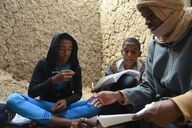
Baba El Hadj, a young schoolboy in Timbuktu, Mali.
Nicolas Réméné / Le Pictorium
LePictorium_0280443.jpg
For the past year, two or three times a week after school, Baba El Hadj has been attending calligraphy classes with his teacher Boubacar Sadek at the Arts et Métiers workshop for manuscript copyists. The workshop is also located in the Djingareyber district, not far from the famous mosque of the same name in Timbuktu. He would like to make a living out of it one day and copy ancient manuscripts. Portrait of Baba El Hadj, a schoolboy in Timbuktu. Baba El Hadj Sidi Ahmed, 14, lives with his uncle Baba Moulaye Al Arby in the Djingareyber neighbourhood, not far from the famous mosque of the same name. His uncle is also the marabout of the Koranic school (Medersa) Cheick Bashir Mohamed Lemine created by his grandfather, which is adjacent to the family home and offers a traditional Muslim religious education. It is here that Baba El Hadj learns every morning to read, write and memorise the Koran in Arabic. The medersa currently accommodates about 180 young schoolchildren. At lunchtime, Baba El Hadj often eats at his uncle's house where one of his aunts, Yaya Baba, prepares Timbuktu specialities such as toukassou or widjila, before returning to the Yehia Alkaya Ibrahim secondary school. On average, Baba El Hadj spends 4 hours a day at the medersa and then 6 hours at the basic school where he studies general subjects such as French, history-geography, civic and moral education, English, mathematics and science. For the past year, two or three times a week after school, Baba El Hadj has been attending calligraphy classes with his teacher Boubacar Sadek at the Arts et Métiers workshop devoted to copyists applied to manuscripts. He would like to make a living out of it one day and copy ancient manuscripts.
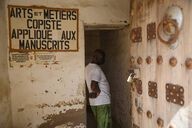
Baba El Hadj, a young schoolboy in Timbuktu, Mali.
Nicolas Réméné / Le Pictorium
LePictorium_0280444.jpg
The Arts and Crafts workshop dedicated to copyists applied to manuscripts, in the Djingareyber district of Timbuktu, not far from the famous mosque of the same name. Portrait of Baba El Hadj, a schoolboy in Timbuktu. Baba El Hadj Sidi Ahmed, 14, lives with his uncle Baba Moulaye Al Arby in the Djingareyber neighbourhood, not far from the famous mosque of the same name. His uncle is also the marabout of the Koranic school (Medersa) Cheick Bashir Mohamed Lemine created by his grandfather, which is adjacent to the family home and offers a traditional Muslim religious education. It is here that Baba El Hadj learns every morning to read, write and memorise the Koran in Arabic. The medersa currently accommodates about 180 young schoolchildren. At lunchtime, Baba El Hadj often eats at his uncle's house where one of his aunts, Yaya Baba, prepares Timbuktu specialities such as toukassou or widjila, before returning to the Yehia Alkaya Ibrahim secondary school. On average, Baba El Hadj spends 4 hours a day at the medersa and then 6 hours at the basic school where he studies general subjects such as French, history-geography, civic and moral education, English, mathematics and science. For the past year, two or three times a week after school, Baba El Hadj has been attending calligraphy classes with his teacher Boubacar Sadek at the Arts et Métiers workshop devoted to copyists applied to manuscripts. He would like to make a living out of it one day and copy ancient manuscripts.
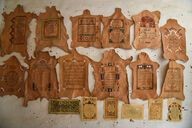
Baba El Hadj, a young schoolboy in Timbuktu, Mali.
Nicolas Réméné / Le Pictorium
LePictorium_0280445.jpg
The Arts and Crafts workshop dedicated to copyists applied to manuscripts, in the Djingareyber district of Timbuktu, not far from the famous mosque of the same name. Portrait of Baba El Hadj, a schoolboy in Timbuktu. Baba El Hadj Sidi Ahmed, 14, lives with his uncle Baba Moulaye Al Arby in the Djingareyber neighbourhood, not far from the famous mosque of the same name. His uncle is also the marabout of the Koranic school (Medersa) Cheick Bashir Mohamed Lemine created by his grandfather, which is adjacent to the family home and offers a traditional Muslim religious education. It is here that Baba El Hadj learns every morning to read, write and memorise the Koran in Arabic. The medersa currently accommodates about 180 young schoolchildren. At lunchtime, Baba El Hadj often eats at his uncle's house where one of his aunts, Yaya Baba, prepares Timbuktu specialities such as toukassou or widjila, before returning to the Yehia Alkaya Ibrahim secondary school. On average, Baba El Hadj spends 4 hours a day at the medersa and then 6 hours at the basic school where he studies general subjects such as French, history-geography, civic and moral education, English, mathematics and science. For the past year, two or three times a week after school, Baba El Hadj has been attending calligraphy classes with his teacher Boubacar Sadek at the Arts et Métiers workshop devoted to copyists applied to manuscripts. He would like to make a living out of it one day and copy ancient manuscripts.
Next page
